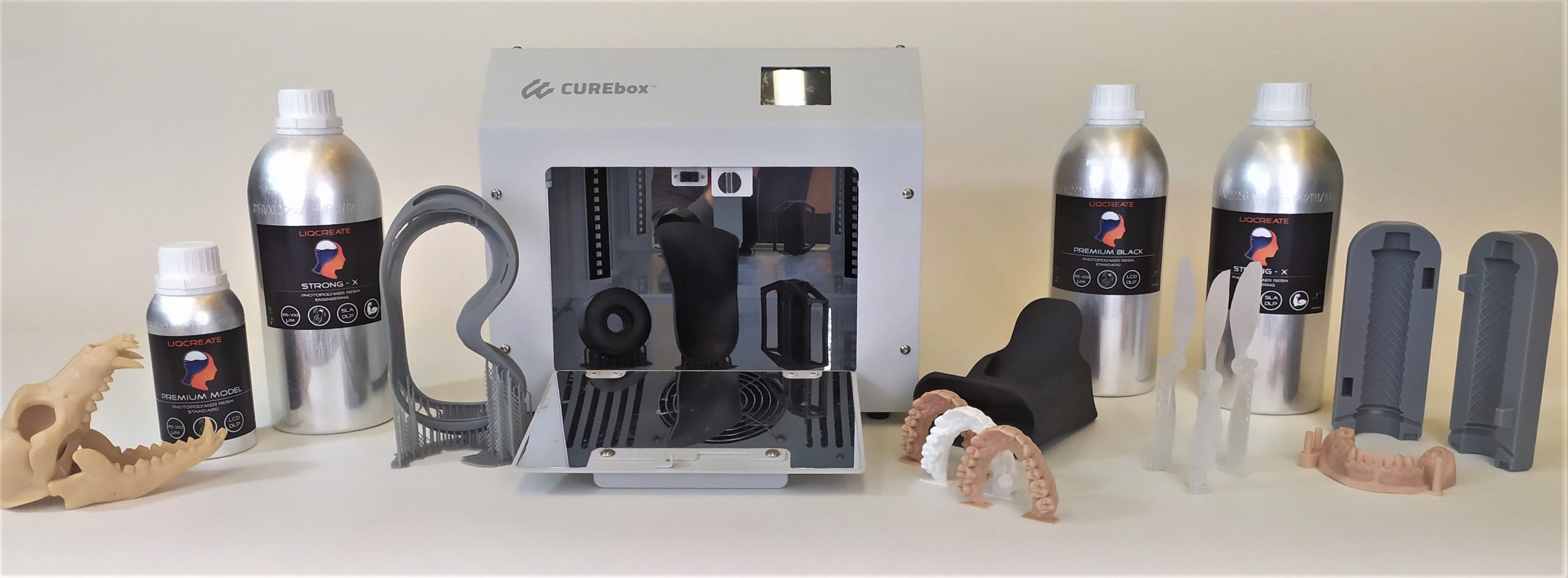When using new materials in resin 3D-printing, they sometimes need a bit different post-processing. For instance when changing from rigid to flexible resin materials, the finished products can sometimes feel sticky. In this article we explain why the parts are sticky and what you can do about it. if you have any questions, feel free to contact us at info@liqcreate.com.
Why are 3D-printed resin parts sometimes sticky?
One of the biggest differences between SLA-based 3D-printing in regard to other 3D-printing technologies is that a chemical reaction has to occur to create a layer. The reaction that occurs is light activating radicals to start polymerization of monomers. This specific chemical reaction is a very controlled reaction, leading to the high accuracy of which SLA is known for. However, one of its disadvantages is that the reaction is sensitive to oxygen. This means that an oxygen rich environment may disrupt the reaction and result in a sticky surface.
When too many reactive particles are reacting with oxygen, a half-cured resin will be formed. The end-result is a sticky or tacky surface. During a top-down SLA, DLP or MSLA / LCD printing process, the resin is cured on the bottom of the resin tank. There is not enough oxygen present to disrupt the process at the bottom of the resin tank. However, oxygen is present during post-curing (in air). This is the main cause of surface stickiness in resin 3D-printed parts
Post-processing to get non – sticky resin parts
Post-processing is an essential step in resin based 3D-printing. It is important to post-process 3D-printed parts properly to avoid a sticky surface. There are a few methods to reduce stickiness of a resin 3D-printed part. It is best to follow them all if you are facing issues with sticky parts:
- – 3D-printing parameters
- – Washing process
- – Post-curing process
- – What not to do?
3D-Printing parameters
The most important step to reduce sticky surfaces, is to fine-tune your 3D-printing parameters. Check out our list of printers and parameters here. If you are overcuring or undercuring your object, the surface quality is poor. Under-curing leads to not completely formed layers giving a sticky surface. Over-curing leads to a softer outer surface, which is almost impossible to wash off and will leave a sticky surface. It is therefore important that the exposure, especially for highly opaque materials like Premium White, is spot on. Feel free to contact us at info@liqcreate.com if you are having difficulties in this step, or have any other questions.
Washing process
After getting a high quality resin 3D-printed object, the parts need to be cleaned and post-cured. Washing is an important step. The washing step ensures that all residual unreacted resin is washed off and can’t react with oxygen during post-curing. We advise to wash with IPA, Ethanol (preferably >85%) or the Liqcreate resin cleaner. Resin cleaner instructions can be found here. For Ethanol and IPA it is advisable to use 2 rinsing baths. One with used solvent and one with fresh solvent. Wash the parts preferably ultrasonic, and otherwise under agitation for 2 minutes in the used solution, followed by 3 minutes in the fresh Ethanol/IPA. The second rinse in fresh IPA/Ethanol will make sure no resin is left on the surface.
Resin post-curing process
After a part is washed properly, it should be UV post-cured. But is very important that before post-curing, the part should be completely dry. This can be done by putting it on a bench and wait 30 minutes, by (slightly) heating up the parts or by blowing with compressed air. The dry parts should already feel quite non-sticky and can be post-cured. Read this article to know more about the best UV post-curing parameters of a specific resin.
In the medical field, often a more professional method is used to eliminate oxygen during post processing and thus reduce stickiness of 3D-printed parts. Often the parts are post-cured in a Nitrogen chamber. This will result in completely non-sticky objects. For more difficult processable resins, like our Flexible-X, we would recommend to post-cure in an oxygen free atmosphere. This would be either in a Nitrogen chamber, or immersed in a transparent jar of water or glycerol during the first minutes of post-curing.
 Standard UV-curing unit at Liqcreate R&D: the Wicked Engineering Curebox.
Standard UV-curing unit at Liqcreate R&D: the Wicked Engineering Curebox.
What not to do?
There are a few things that would definitely give sticky parts. The first step not to do is to rinse a part that is not completely clean with water. Water and resin won’t mix and give a dirty, sticky surface. Next to water, post-curing not completely clean or dry parts will also lead to a sticky surface. Once a part is UV Post-cure, it is nearly impossible to get the sticky / tacky surface off. It is therefore advised to give a bit extra focus to the whole process to prevent printing parts again.
Support
Do you need any help with 3D printing our SLA, DLP or LCD resins? We can help you! Just look for the question you have below. If you can’t find it, let us know by contacting us!


